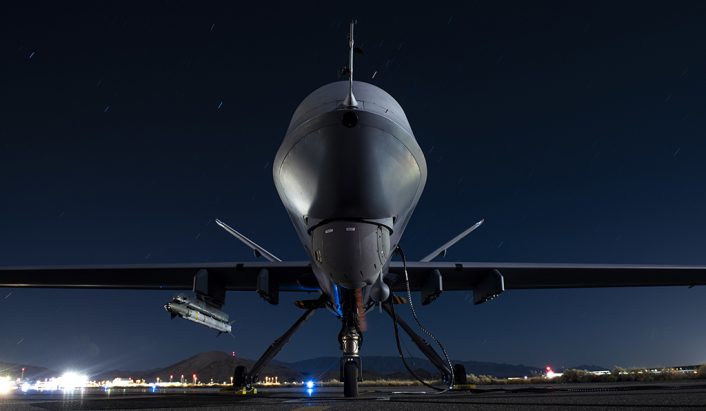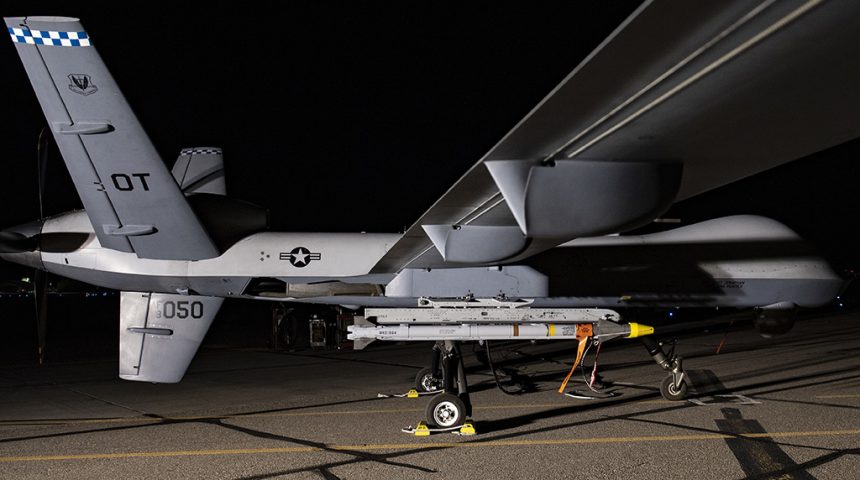This is the second successful MQ-9 AIM-9X employment since the first air-to-air shot in November of 2017 against a target drone.
The U.S. Air Force has recently employed a live AIM-9X Block II air-to-air missile as part of the Advanced Battle Management System Onramp #2. From August 31 to September 3, 2020, the Department of the Air Force, in partnership with U.S. Northern Command and U.S. Space Command, conducted a field test of the Advanced Battle Management System (ABMS), a complex “system of systems” that “allows a joint force to use cutting-edge methods and technologies to rapidly collect, analyze, and share information and make decisions in real time.”
The latest iteration, known as “onramp”, saw operators use ABMS “to detect and defeat efforts to disrupt U.S. operations in space in addition to countering attacks against the U.S. homeland, including shooting down a cruise missile “surrogate” with a hypervelocity weapon.”
ABMS builds an “internet of (military) things” where weapon systems and personnel in the air, on the ground, at sea as well as space and cyber domains are all linked. ABMS collects and fuses information so that information available instantaneously across geographically-separated forces spanning the operational to tactical levels of combat. AI is used to “blend” all the sources and sensors’ data so that a summarized and weighed “picture” of the battlefield can be built, preventing information saturation and freeing up a portion of the cognitive capacity that the warfighters can use to perform other tasks.
Among the test carried out during ABMS Onramp #2 at various sites, one is particularly interesting: a U.S. Air Force MQ-9 Reaper assigned to the 556th Test and Evaluation Squadron successfully employed a live air-to-air AIM-9X Block II missile against a target BQM-167 drone simulating a cruise missile. The crew received off-board cueing information, found and tracked the target, then maneuvered the UAS (Unmanned Aerial System) to validly employ the AIM-9X against the surrogate cruise missile. The official public release states that such a concept of using a drone to target and destroy a cruise missile reportely emerged as a feedback to the Weapons School.
The AIM-9X Block II is an upgraded variant of the “baseline” AIM-9X with increased range alongside Lock-on After Launch and High Off-Boresight (HOBS) capability. Although its exact range is classified and can vary a lot depending on the launch characteristics, target attitude etc, it’s safe to say that the missile, that is also equipped with a two-way datalink, must be fired from a relatively short distance from the in-coming target: this would suggest that the U.S. Air Force envisages the use of unmanned aircraft to provide point and anti-cruise missile defense.

A U.S. Air Force MQ-9 Reaper assigned to the 556th Test and Evaluation Squadron armed with an AIM-9X missile sits on the ramp on September 3, 2020 ahead of the ABMS Onramp #2. In the test, the MQ-9 successfully employed a live air-to-air AIM-9X Block 2 missile against a target BQM-167 drone simulating a cruise missile. (U.S. Air Force photo by SrA Haley Stevens)
In order to carry out this Proof of Concept, several different components had to be connected to share information in the timeframe required to intercept the target: according to the Air Force, the squadron operations cell and the ground-base control station (where the drone cockpit is hosted) was connected to the ABMS network so that the MQ-9 could target the BQM-167.
“Joint All Domain Command and Control (JADC2) provided critical data to the MQ-9 and crew for timely and accurate target information. The network integration and cross-domain solutions proven during the ABMS demonstration significantly decreased the total time from target discovery to engagement to battle damage assessment,” said the U.S. Air Force release.
It was the second test to see an MQ-9 fire an AIM-9x since the first air-to-air shot in November of 2017 against a target drone.
“Since 2017, the MQ-9 community has investigated and proven the efficacy of the MQ-9 in a counterair role utilizing the AIM-9X and future non-kinetic effects. The combined test, weapons school, and industry team since 2009 has demonstrated the capability to integrate the MQ-9’s effects in major combat operations across a variety of missions during large scale exercises at the USAF weapons school, integrating with Naval assets, and flying in numerous combatant commands,” said Lt. Col. Michael Chmielewski, commander, 556th Test and Evaluation Squadron.









